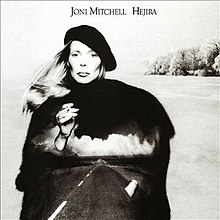Hejira (album)
| Hejira | ||||
|---|---|---|---|---|
 |
||||
| Studio album by Joni Mitchell | ||||
| Released | November 1976 | |||
| Recorded | 1976 | |||
| Studio | A&M Studios, Hollywood | |||
| Genre | Folk jazz, pop jazz, jazz fusion | |||
| Length | 52:18 | |||
| Label | Asylum | |||
| Producer | Joni Mitchell | |||
| Joni Mitchell chronology | ||||
|
||||
| Professional ratings | |
|---|---|
| Review scores | |
| Source | Rating |
| AllMusic | |
| Robert Christgau | B+ |
| Le Guide du CD | GOLD |
| MusicHound | |
| Pitchfork Media | 8.0/10 |
| Rolling Stone | (favorable) |
| The Rolling Stone Album Guide | |
| Martin C. Strong | 9/10 |
| Virgin Encyclopedia of Popular Music | |
| Polari Magazine | |
Hejira is the eighth studio album by Canadian singer-songwriter Joni Mitchell, released in 1976.
The album title is a transliteration of the Arabic word "hijra", which means "journey", usually referring to the migration of the Islamic prophet Muhammad (and his companions) from Mecca to Medina in 622. The songs on the album were largely written by Mitchell on a trip by car from Maine back to Los Angeles, California, with prominent imagery including highways, small towns and snow. The photographs of Mitchell on the front and back cover were taken by Norman Seeff and appear against a backdrop of Lake Mendota, in Madison, Wisconsin, after an ice storm.
The album did not sell as well as its predecessors, peaking at #22 in Mitchell's native Canada, although it still reached #13 on the Billboard 200 pop album chart and was certified Gold, and #11 in the UK where it has been certified Silver. Critically, the album was generally well received and has since been recognized as one of the high-water marks in Mitchell's career.
According to Mitchell, the album was written during or after three journeys she took in late 1975 and the first half of 1976: a stint on the Rolling Thunder Revue with Bob Dylan in late 1975 when she became a frequent cocaine user, a concert tour cancelled after six weeks in February 1976 when Mitchell and drummer John Guerin ended their on-again, off-again relationship, and a road trip Mitchell undertook shortly after the tour with two men, one of them a former lover from Australia, that inspired six of the songs on the album. She drove with her two friends from Los Angeles to Maine, and then went back to California alone via Florida and the Gulf of Mexico. She traveled without a driver's licence and stayed behind truckers, relying on their habit of signaling when the police were ahead of them; consequently, she only drove in daylight hours. After recording the tracks, she met bassist Jaco Pastorius and they formed an immediate musical connection; Mitchell was dissatisfied with what she called the "dead, distant bass sound" of the 1960s and early 1970s, and was beginning to wonder why the bass part always had to play the root of a chord. She overdubbed his bass parts on four of the tracks on Hejira and released the album in November 1976.
...
Wikipedia
